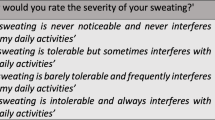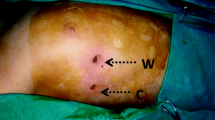Abstract
Background
Endoscopic thoracic sympathectomy/sympathotomy is gold standard of treatment for primary hyperhidrosis. Compensatory hyperhidrosis following surgery and partial response to surgery in some patients can significantly affect surgery outcome and patient satisfaction. In this study we investigated predictors of success rate, side effects, and satisfaction of our patients following ETS over a 10-year period.
Methods
We retrospectively reviewed result of 200 Endoscopic thoracic sympathotomy surgeries that was performed in a single center to treat craniofacial, palmar, or axillary primary hyperhidrosis over a 10-year period. Patients were asked to report success of surgery to resolve their primary hyperhidrosis, development of compensatory hyperhidrosis, its severity, and their overall satisfaction with surgery.
Results
Palmar hyperhidrosis was resolved in 167 (94%) patients. Craniofacial hyperhidrosis was resolved in 66 (84%) patients. Axillary hyperhidrosis was resolved in 68 (50%) patients. Compensatory hyperhidrosis developed in 176 (88%) patients. 44 (22%) patients had mild CHH, 79 (40%) patients developed moderate CHH, and 52 (26%) patients experienced severe CHH. A total of 173 (87%) patients were satisfied with surgery. 19 (9%) patients were not satisfied with ETS and 8 (4%) patients regretted ETS. Lower body mass index and grade IV primary hyperhidrosis were found to be independent predictors of patient satisfaction. Pure axillary primary hyperhidrosis was a negative predictor of patient satisfaction.
Conclusion
Best results of ETS are achieved in patients with grade IV PHH and lower body mass indexes. Outcome of ETS for treating axillary PHH is not favorable.
Graphic abstract

Similar content being viewed by others
References
Hornberger J, Grimes K, Naumann M et al (2004) Recognition, diagnosis, and treatment of primary focal hyperhidrosis. J Am Acad Dermatol 51(2):274–286
Solish N, Bertucci V, Dansereau A et al (2007) A comprehensive approach to the recognition, diagnosis, and severity-based treatment of focal hyperhidrosis: recommendations of the Canadian Hyperhidrosis Advisory Committee. Dermatol Surg 33(8):908–923
Kotzareff A (1920) Re´section partielle du tronc sympathique cervical droit pour hyperhidrose unilate´rale (re´gions faciale, cervicale, thoracique et brachiale droites). Rev Med Suisse Rom 40:111–113
Munia MA, Wolosker N, Kaufmann P, de Campos JR, Puech-Leão P (2008) Sustained benefit lasting one year from T4 instead of T3–T4 sympathectomy for isolated axillary hyperhidrosis. Clinics (Sao Paulo). 63(6):771–4
Cerfolio RJ, De Campos JR, Bryant AS et al (2011) The Society of Thoracic Surgeons expert consensus for the surgical treatment of hyperhidrosis. Ann Thorac Surg 91(5):1642–1648
Heidemann E, Licht PB (2013) A comparative study of thoracoscopic sympathicotomy versus local surgical treatment for axillary hyperhidrosis. Ann Thorac Surg 95(1):264–268
Atkinson JL, Fode-Thomas NC, Fealey RD et al (2011) Endoscopic transthoracic limited sympathotomy for palmar–plantar hyperhidrosis: outcomes and complications during a 10-year period. Mayo Clin Proc 86(8):721–729
Sang HW, Li GL, Xiong P et al (2017) Optimal targeting of sympathetic chain levels for treatment of palmar hyperhidrosis: an updated systematic review. Surg Endosc 31(11):4357–4369
Zhang W, Wei Y, Jiang H et al (2017) T3 versus T4 thoracoscopic sympathectomy for palmar hyperhidrosis: a meta-analysis and systematic review. J Surg Res 218:124–131
Salim EF, Ali GA (2018) Impact of thoracoscopic T2 sympathectomy on patients with primary palmar and axillary hyperhidrosis. Ann Thorac Surg 106(4):1032–1037
Gunn TM, Davis DM, Speicher JE et al (2014) Expanded level of sympathetic chain removal does not increase the incidence or severity of compensatory hyperhidrosis after endoscopic thoracic sympathectomy. J Thorac Cardiovasc Surg 148(6):2673–2676
Wolosker N, Ishy A, Yazbek G et al (2013) Objective evaluation of plantar hyperhidrosis after sympathectomy. Clinics (Sao Paulo) 68(3):311–315
Dobosz L, Cwalina N, Stefaniak T et al (2017) Influence of body mass index on compensatory sweating in patients after thoracic sympathectomy due to palmar hyperhidrosis. Thorac Cardiovasc Surg 65(6):497–502
Leiderman DBD, Milanez de Campos JR, Kauffman P et al (2018) The relation between age and outcomes of thoracic sympathectomy for hyperhidrosis: the older the better. J Thorac Cardiovasc Surg 156(4):1748–1756
de Campos JR, Wolosker N, Takeda FR, Kauffman P, Kuzniec S, Jatene FB, de Oliveira SA (2005) The body mass index and level of resection: predictive factors for compensatory sweating after sympathectomy. Clin Auton Res 15(2):116–120
Faustino CB, Milanez de Campos JR, Kauffman P et al (2019) Analysis of the results of videotoracoscopic sympathectomy in the treatment of hyperhidrosis in patients 40 years or older. Ann Vasc Surg. https://doi.org/10.1016/j.avsg.2019.04.024
Bryant AS, Cerfolio RJ (2014) Satisfaction and compensatory hyperhidrosis rates 5 years and longer after video-assisted thoracoscopic sympathotomy for hyperhidrosis. J Thorac Cardiovasc Surg 147(4):1160–1163
Dumont P, Denoyer A, Robin P (2004) Long-term results of thoracoscopic sympathectomy for hyperhidrosis. Ann Thorac Surg 78(5):1801–1807
Author information
Authors and Affiliations
Corresponding author
Ethics declarations
Disclosures
Karamollah Toolabi, Reza Parsaei, Roya Farid, and Abbas Zamanian declare that they have no conflict of interest.
Additional information
Publisher's Note
Springer Nature remains neutral with regard to jurisdictional claims in published maps and institutional affiliations.
Rights and permissions
About this article
Cite this article
Toolabi, K., Parsaei, R., Farid, R. et al. Endoscopic thoracic sympathotomy for primary hyperhidrosis: predictors of outcome over a 10-year period. Surg Endosc 36, 3585–3591 (2022). https://doi.org/10.1007/s00464-021-08684-8
Received:
Accepted:
Published:
Issue Date:
DOI: https://doi.org/10.1007/s00464-021-08684-8




